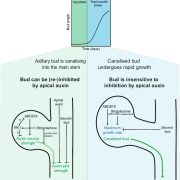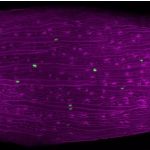Strawberry inflorescence diversity: meet the thyrse
Lembinen et al. explore the molecular mechanisms underlying inflorescence diversity in strawberry.
Sergei Lembinen1, Mikolaj Cieslak2, Teng Zhang1, Kathryn Mackenzie1, Paula Elomaa1, Przemyslaw Prusinkiewicz2, Timo Hytönen1.
1 Department of Agricultural Sciences, Viikki Plant Science Centre, University of Helsinki, P.O. Box 27, FIN-00014 Helsinki, Finland
2 Department of Computer Science, University of Calgary, Calgary, AB T2N 1N4
Background: Plants organize their flowers into clusters called inflorescences. The branching patterns and architecture of these clusters are crucial to a plant’s reproductive success and agricultural yield. The extensive variability of inflorescence architectures in strawberries was documented a century ago. Since then, inconsistent characterizations of strawberry inflorescence architectures have accumulated. To clarify these inconsistencies, we studied the architecture and development of strawberry inflorescences at the macro and micro scales using diploid woodland strawberry (Fragaria vesca) as a model plant.
Question: We wanted to understand how the diversity of strawberry inflorescences is regulated at developmental and molecular levels.
Findings: Woodland strawberries produce compound inflorescences that consist of a primary monopodial axis bearing sympodial lateral branches. The primary axis and lateral branches are produced by geometrically distinct meristems. The resulting architecture, known as a thyrse, is not found in other previously studied model plants. The diversity of thyrse architecture originates from a variable number of lateral branches on the primary axis and a variable number of sympodial branching iterations. At the molecular level, both numbers are controlled by two homologous proteins, TERMINAL FLOWER 1 (FvTFL1) and FLOWERING LOCUS T1 (FvFT1), which regulate the timing of cessation of branching. The observed diversity of woodland strawberry inflorescences has been reproduced using a computational model that takes into account the functions of FvTFL1 and FvFT1.
Next steps: Detailed molecular level mechanisms that drive the differences between the meristems and create thyrse architecture should be discovered to facilitate our understanding of the evolution of the morphological diversity in nature. This knowledge can be translated into the development of new breeding strategies to optimize the yield and quality of berries in cultivated strawberry.
Reference:
Sergei Lembinen, Mikolaj Cieslak, Teng Zhang, Kathryn Mackenzie, Paula Elomaa, Przemyslaw Prusinkiewicz, Timo Hytönen. (2023). Diversity of woodland strawberry inflorescences arises from heterochrony regulated by TERMINAL FLOWER 1 and FLOWERING LOCUS T. https://doi.org/10.1093/plcell/koad086







